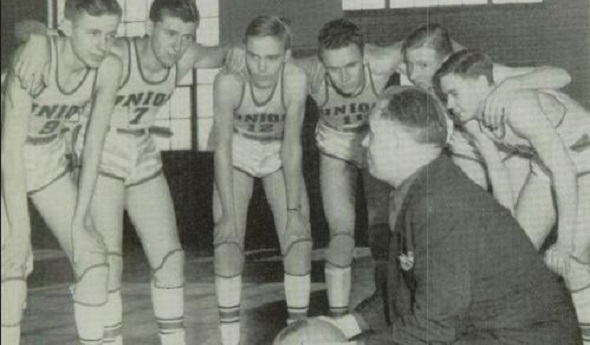
The Last Time MHSAA Finals were Canceled
By
Ron Pesch
MHSAA historian
April 27, 2020
Historians trace the start of World War II to German dictator Adolph Hitler’s decision to invade Poland on September 1, 1939. The Empire of Japan’s involvement in the war became effective in September 1940 with the signing of the Tripartite Pact.
Until December 7, 1941, the United States avoided official involvement, declaring themselves “a neutral nation.” Then came Imperial Japan’s bombing of Pearl Harbor.
A labor shortage caused by World War I had taken out spring high school sports in Michigan in 1917. As noted in the Second Half article, “1918 Pandemic, WWI Threatened High School Sports,” the global spread of a devastating strain of influenza interrupted the football season in Michigan. Prep athletics would roar through the 1920s and survive the Great Depression before seeing another interruption.
That next disturbance had nothing to do with war’s insatiable desire for manpower. Rather, it was because of tires.
“When the Japanese bombed Pearl Harbor, rubber instantly became the most critical strategic material for making war,” wrote Stephen W. Sears in the October/November issue of American Heritage magazine in 1979. “Nine-tenths of the nation’s rubber came from the Far East, and it was painfully evident that nothing would now stop Japan from cutting off that source.”
Americans consumed nearly two-thirds of the world’s production of rubber. With only about a year’s worth of material on hand, “Just four days after Pearl Harbor a freeze was put on the sale of new passenger-car tires,” stated Sears, “and on December 27 tire rationing was authorized, to go into effect early in January, 1942. Sales of new cars also were halted.”
The MHSAA
The Michigan High School Athletic Association arrived in December 1924. It replaced the old Michigan Interscholastic Athletic Association which had served Michigan for 15 years.
The organization’s primary purpose was to standardize, interpret and administer rules, educate and guide officials, and regulate student eligibility within prep sports in Michigan. By the 1940s, it had evolved into an association that also managed postseason tournaments, designed to identify state champions in specific sports: swimming, cross country, golf, tennis, track, and the sport sponsored by the most high schools in the state, basketball.
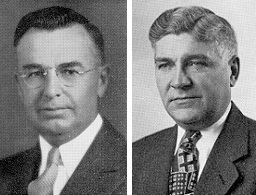 “The old MIAA had taken over the regulation of basketball tournaments in 1920. This had been done as a service to the schools and especially as a means of eliminating evils inherent in the invitational tournaments (that were hosted by various colleges around the state and the midwest),” wrote Lewis L. Forsythe in his book, Athletics in Michigan High Schools, recalling the first 100 years of prep sports in the state.
“The old MIAA had taken over the regulation of basketball tournaments in 1920. This had been done as a service to the schools and especially as a means of eliminating evils inherent in the invitational tournaments (that were hosted by various colleges around the state and the midwest),” wrote Lewis L. Forsythe in his book, Athletics in Michigan High Schools, recalling the first 100 years of prep sports in the state.
“In the last days of February 1942,” multiple Michigan schoolmen were in San Francisco to attend the annual meetings of Secondary School Principals, Superintendents and the National Federation of State High School Associations. “We were well aware that many of our boys in school would have to offer themselves in the service of their country,” noted Forsythe in his publication. “We fully realized that the quality of that service and, indeed, their own survival might well depend quite as much on their physical fitness as on their intellectual and spiritual resources. It was under those circumstances that we determined so to modify the emphasis of our athletic program as to make the largest possible contribution to the war effort. We recognized that the need in Michigan could not be met by our organization alone, and we therefore determined to encourage a general enrollment of all school groups in a united effort for promotion of physical fitness.”
Because of the “scarcity of tires and automobiles,” in April 1942 the MHSAA announced plans to curtail their upcoming annual golf and tennis events, eliminating a state championship round. Instead, the seasons were concluded with separate eastern and western sectional tournaments, hosted in Ann Arbor and Grand Rapids.
Early in May of 1942, MHSAA executive director Charlie Forsythe, nephew of Louis Forsythe, announced that the Association was “working on plans designed to make body-building exercises available to more young men and to spread recognition of sports achievements. He predicted substantial growth of intramural sports to include youngsters whose limited prowess might keep them from such interscholastic sports as football, baseball or basketball.”
Wire articles had told the story of how the running Battle of the Atlantic had impacted U.S. ocean transportation along the eastern seaboard. A Germany-mounted “campaign against American coastal shipping” by U-boats (submarines) was devastating “a section of America almost exclusively dependent upon ocean-point tankers for its petroleum products.” Without a viable alternative means to transport the products, on May 15, 1942, gasoline rationing began in 17 seaside states and the District of Columbia. It was hinted that gas rationing – specifically designed to save rubber – could roll out nationally. (Crude oil is the main ingredient in man-made rubber.)
The chances for restrictions in Michigan were a distinct possibility. According to P.J. Hoffmaster, the state’s supervisor of wells, the state consumed approximately 140,000 barrels of oil per day, but produced only 64,054 barrels. “This state has a shortage of at least 100,000 barrels on the basis of a regional demand,” he said, noting Michigan oil also supported needs outside the state. “When people say there can’t be rationing in Michigan because we have plenty of our own oil, they don’t have the true picture.”
Reverberations begin
When quizzed on the subject before the annual Lower Peninsula Track and Field championships, hosted at Michigan State College in May 1942, (Charlie) Forsythe, told The Associated Press he was unsure how rationing might affect the Association’s annual playoffs.
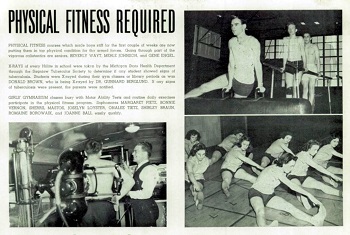 “It is too early as yet to say exactly. … We are making every effort to maintain an adequate athletic program. Certainly where common carriers (busses and trains) will make it possible to get a team to a game, that means should be used,” Forsythe said. He added that the Association was “surprised to find the number of schools competing in this year’s tournaments practically equaled last year’s entries.”
“It is too early as yet to say exactly. … We are making every effort to maintain an adequate athletic program. Certainly where common carriers (busses and trains) will make it possible to get a team to a game, that means should be used,” Forsythe said. He added that the Association was “surprised to find the number of schools competing in this year’s tournaments practically equaled last year’s entries.”
A total of 162 schools had qualified individual contestants in the track championships, about 10 percent fewer than in 1941. However, L.L. Frimodig – the assistant director of college athletics at M.S.C. and acting director of the state track meet – felt “the actual field in the four-class carnival would be much smaller than the number eligible to compete,” considering the circumstances of travel. “Many coaches,” he said, “would think in terms of tires rather than trophies before embarking on any sizable journey to the meet.”
The threat of rationing was almost immediately seen within Michigan’s resorts and travel industry.
“July and August have been moved up into June,” wrote the Detroit Free Press. “This is the word that comes from various parts of the state. Evidently, determination to get the vacation over before gas rationing may be decreed is one of the factors that has stepped up the season. … Reports of heavy patronage at nearby resorts over Memorial Day week-end can be taken as an indication of the trend, or necessity in 1942 of holidays enjoyed close to home base.”
Come September, Joseph B. Eastman, national director of the office of war transportation, called for help in reducing consumption of natural resources: “We intend to solicit the help of colleges and universities in making arrangements for transfer of scheduled games to centers of population where as many people as possible will have an opportunity to attend football games without traveling.”
At the college level, the freshman eligibility rule was waived due to the loss of manpower tied to military enlistment and the enactment of the Selective Training and Service Act of 1940. Its passage required all men between ages 21 and 45 to register for the first peacetime draft in U.S. history. With entry into the war, in December 1941, it was amended to require all 18 to 64-year-olds to register, with starting age for likely draft lowered to 20.
“The seasons of 1942-45 turned the (college) game upside down, creating new juggernauts and decimating some old ones,” wrote Sports Illustrated in its 1971 article, “When Football Went to War.”
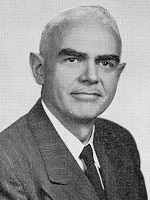 “Michigan’s 85 high school athletic leagues are speculating on the effects of the office of defense transportation plan to whittle sports travel drastically,” stated an Associated Press (AP) article soon after Eastman’s announcement. The Southwestern Conference, comprised of Kalamazoo Central, Benton Harbor, Muskegon, Holland, Grand Haven and Muskegon Heights and one of the most widely spread major prep circuits in the state, was told by its regular bus company that its busses were not available for charter.
“Michigan’s 85 high school athletic leagues are speculating on the effects of the office of defense transportation plan to whittle sports travel drastically,” stated an Associated Press (AP) article soon after Eastman’s announcement. The Southwestern Conference, comprised of Kalamazoo Central, Benton Harbor, Muskegon, Holland, Grand Haven and Muskegon Heights and one of the most widely spread major prep circuits in the state, was told by its regular bus company that its busses were not available for charter.
On Sept. 25, according to AP, “the state department of public instruction warned today that a threat of ‘no new tires’ will be held over rural schools which use their school busses to transport football players to and from games.”
Julian W. Smith, named the interim director of the MHSAA when Charlie Forsythe went into military service, didn’t think the directive would have much impact on football schedules. “However, I believe the order will have a serious effect on basketball schedules this winter and on next year’s football schedule.”
“Four Gallons a Week for Most Drivers”
Two days later it was announced that nationwide gas rationing would go into effect at the beginning of December 1942. More immediately, compulsory tire inspections every 60 days and a “Victory Speed Limit” of 35 miles per hour, effective Oct. 1, were also enacted. “This is not a gasoline rationing program, but a rubber conservation program,” said William M. Jeffers, president of the Union Pacific Railroad, which had been placed in charge of the government’s struggle to alleviate the rubber shortage.
“The object is not to take cars off the road, but to keep them on the road. … The safe life of a tire at 50 miles per hour is only half as great as it is at 30 m.p.h.”
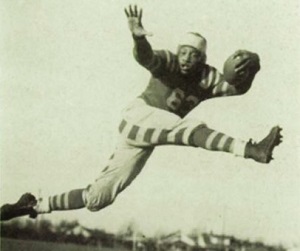 After initial announcements of game cancellations, the impact on high school football in Michigan in 1942 appears to have been minimal. Solutions were found to most challenges. In Bessemer, the high school superintendent announced that “enough persons have volunteered their automobiles to take the Speed Boy players to Calumet” for the game, scheduled for Saturday, Oct. 3. At season’s end, Flint Northern, Detroit Catholic Central, Muskegon, and Wyandotte each lay claim to a share of Michigan’s mythical football title.
After initial announcements of game cancellations, the impact on high school football in Michigan in 1942 appears to have been minimal. Solutions were found to most challenges. In Bessemer, the high school superintendent announced that “enough persons have volunteered their automobiles to take the Speed Boy players to Calumet” for the game, scheduled for Saturday, Oct. 3. At season’s end, Flint Northern, Detroit Catholic Central, Muskegon, and Wyandotte each lay claim to a share of Michigan’s mythical football title.
But a hint of what was to follow came with an announcement concerning the annual Cross Country Finals. The state meet was cancelled to reduce travel, with honors instead awarded during October meets to which schools were assigned based on geography.
In its October 1942 bulletin, the MHSAA endorsed a commando-type “training plan drafted by the Minnesota branch of the office of civilian defense” to “step up scholastic physical fitness programs.” When plotted on a football field, the course bordered the playing area with 11 obstacles spaced 20 yards apart. The course required participants to jump a 4-foot fence, crawl under a 2-foot-high rope, then run between a maze of stakes and, later in the course, high-step through a series of open boxes. Students would scale a 7½-foot wall, walk on a 12-foot balance beam, swing across a broad jump pit from a rope that hung from above, then climb another rope hung from the crossbar of the goal posts. Once accomplished, the participant was to move, hand-over-hand, across the span of the crossbar before dropping to the ground.
At the end of October, the MHSAA’s Representative Council acknowledged the direct contribution that interscholastic sports had on the “lives of students and citizens of the communities in which they are offered” while recommending that they be “retained insofar as possible.”
The committee, however, also emphasized its belief “that physical fitness programs for all students, and intramural sports to offer opportunity for competition to all, should be stressed in the schools’ athletics program.
“In all probability,” it continued, “it will be necessary to modify the general plans of conducting tournaments.” The mechanics of modification would be hammered out at the next Council meeting to be held in December in Lansing.
Financial concerns also were expressed, as much of the Association’s operating budget came from a share of gate receipts of tournaments.
The Impact
“All over the state, athletic directors and coaches are tackling transportation problems. Instead of piling the athletes into privately owned automobiles or school busses, coaches have diligently studied timetables of regular train and bus lines with many satisfactory results,” stated the AP on Dec. 4.
That same day, the MHSAA announced that the upcoming basketball postseason would be altered due to rationing. The story was picked up by various newspapers across the Midwest.
“The association’s Representative Council last night stressed need for following a ‘principle of minimum travel’ in basketball play this winter and voted to dispense with the annual Lower Peninsula finals,” instead opting for a modified layout. Initial conversation related to a plan calling for sectional meets with the possibility of naming titles in the northern half of the Lower Peninsula, and in both the southern and eastern areas. An appointed basketball committee was also to consider combining enrollment classifications wherever necessary to localize tournament play.
From 1932-1947, inclusive, separate Lower and Upper Peninsula basketball champions were determined. The Upper Peninsula Athletic Committee announced a similar plan at its meeting in January of 1943. The committee expected to present winners of the U.P. events with certificates instead of the customary trophies due to shortage of materials prompted by the war.
According to a survey of its 40 member state associations by the National Federation of State High School Associations, Michigan was one of only four states, including Maine, Montana and Nevada, to eliminate naming basketball state champions come the winter of 1943, “since the distances within those states are too vast or transportation facilities are too limited. The same will prevail in track contests.”
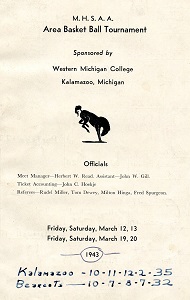 By mid-January, the MHSAA had polled its membership, and approximately 95 percent of the state’s high schools indicated a desire to participate in the replacement tournaments pitched by the Association. After examining the logistics, the plan previously discussed was modified. The Association then identified 51 Lower and 11 Upper Peninsula sites, based on availability to host the tournament and geographic suitability. The competition would run for two weeks, and end with what had previously equaled District championship contests.
By mid-January, the MHSAA had polled its membership, and approximately 95 percent of the state’s high schools indicated a desire to participate in the replacement tournaments pitched by the Association. After examining the logistics, the plan previously discussed was modified. The Association then identified 51 Lower and 11 Upper Peninsula sites, based on availability to host the tournament and geographic suitability. The competition would run for two weeks, and end with what had previously equaled District championship contests.
In the meantime, the annual swim championships were reduced to a one-day meet. Hosted at the University of Michigan, the meet would tax the endurance of individual swimmers, “since officials … decided to conduct semi-final events additional to the customary qualifying trials and finals.” That meant a swimmer entered in two events could compete six times during the day, with qualifying events in the morning, semifinals in the afternoon and finals swum at night. Perennial powers Battle Creek Central and Ann Arbor University High emerged as champions.
“The war to date has proved one thing conclusively – athletics in all schools must go on, for they serve to properly condition our young men for the bigger task ahead,” said MHSAA interim director Smith, speaking at an “annual football and basketball ‘bust’ for Lakeview High School” in Battle Creek in February 1943. Smith had served as principal at the high school for 14 years before taking over at the MHSAA. He “expressed regret” that the MHSAA had altered the various formats of the annual championships. According to coverage of the gathering in the Battle Creek Enquirer, “he intimated that it, along with all other forms of statewide competition, would be restored before another school year begins.”
Continued Chaos
The cities of Lansing and Kalamazoo played host to the most contingents, with 25 teams across the four enrollment classifications playing games at recently completed Lansing Sexton – the rechristened Lansing Central High School – and the Lansing Boys Vocational School. A total of 23 schools squared off at Western Michigan College of Education (now Western Michigan University).
As previously stated, transportation considerations meant some schools played above or below their normal classification to make things work. Ecorse, normally a Class B school, battled in the Class A tournament hosted at Dearborn Fordson. Benton Harbor, with Class A enrollment numbers, competed in the Class B tournament played across the St. Joseph River at St. Joseph High School instead of at the Kalamazoo Area tournament against similarly-sized schools.
A total of 128 area titles were awarded across the state’s two peninsulas. Decatur, the Class C state champion in 1942 with a 25-0 record, was the only team titlist to repeat in 1943, emerging with one of the “Area” crowns and extending its streak of victories to 41 consecutive. Also among the winners was Grand Rapids Union, a “cellar team in the regular season.”
“Although Union stood seventh in the city tally, the Red Hawks won the Area Tournament Crown in three smashing, spine-tingling battles,” stated the sports editor in the 1943 Aurora - Union’s yearbook. “In fast games the Hawks overcame Catholic and beat the Creston Bears … as well as whipping Davis Tech for their final victory.”
In April, the MHSAA confirmed that competition would end with area, city or conference meets in track, and again in tennis and golf, because of transportation, participation issues, and the “prospects of closing of some of the schools early.”
Various fans and media members grumbled about the unsatisfying conclusion to the prep sports calendars.
Hope
The coaching ranks were heavily hit by the war, as numerous mentors were tapped by the armed forces to lead physical fitness programs. Despite initial concerns, few “of the state’s 400 football-playing prep schools” dropped the sport come the 1943-44 school year. As it would turn out, because of the travel constraints, attendance increased as more and more sports fans turned to high school competition for entertainment.
Smith stated in October that he had “yet to find anyone who is definitely against bringing the (basketball) championship tournament back to life. There seems to be overwhelming sentiment in favor of the revival. The schools right-about face on the state cage classic which annually drew 700 prep teams and 11,000 players is explained by the fact coaches now feel the federal government is strongly in favor of any attempt to encourage or extend athletics. Last year schoolmen were not certain what the government’s attitude on sports would be and were hesitant about continuing athletics in pre-war style.”
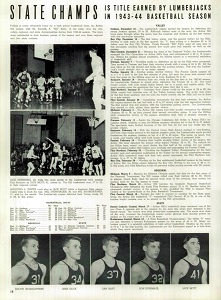 Only 258 of 614 schools replied to a questionnaire about restoring the winter basketball state championships, but 73 percent of respondents were in favor of such, and in December, the Representative Council voted to resume the final rounds of the tournaments.
Only 258 of 614 schools replied to a questionnaire about restoring the winter basketball state championships, but 73 percent of respondents were in favor of such, and in December, the Representative Council voted to resume the final rounds of the tournaments.
Born October 1918 in St. Johns, Michigan at the peak of the “Spanish Flu” pandemic, Hal Schram was a 25-year-old sports reporter for the Lansing State Journal when he covered the restart.
“State championship basketball and track competition once more became a part of (the) Michigan high school athletic program when the Representative Council of the MHSAA voted to reinstate these two state-wide tournaments after a suspension of one year,” he wrote.
According to Schram, “It was believed that student working hours, transportation, scarcity of balls and general lack of interest” still necessitated cancellation of golf and tennis tournaments for the year. Conduction of a swimming championship was left “in the hands of a committee representing schools which sponsor the sport … subject to the approval of the representative committee.”
Plans were to return the final rounds of the basketball tournament to Jenison Field House on the campus of Michigan State, which had hosted those rounds from 1940-42. However, the facility was in use by Army trainees for a physical fitness program.
“We would like to have the finals staged here very much,” said MSC athletic director Ralph Young, “but our obligations to the army come first.”
“Despite the hitch, the executive committee opted to stay in Lansing, playing Class A and C semifinal contests at the Boys Vocational School fieldhouse, and Class B and D semi games at Sexton High School. Finals were held at the Vocational gym.
“Fifty-five hundred spectators jammed their way into every nook and cranny of the Boys Vocational school fieldhouse last night to see four high school teams (Saginaw Arthur Hill, Marshall, Lansing St. Mary, Benton Harbor St. John) win championships in the Lower Peninsula tournament finals. With all seats taken almost before the first game started, the big floor was completely encircled by people sitting and standing before the finish,” wrote State Journal sports editor George S. Alderton. “By 6 o’clock, when the Class D game started, all seats in the side bleachers had been filled and most of the end bleachers were gone. The last vacancy was occupied before the Class C game started at 7:15 o’clock and from that time on, those who came either stood or seized a seat left by some departing fan. In many instances two sat down when one departed. Corners of the court were seething masses of humanity …”
United Press International wire reports indicated that 8,500 in total saw the Finals, as fans shifted in and out of the venue in support of the participating teams. “Some people had to be turned away at the finals,” said Smith, “and that certainly shows that people need and want this kind of relaxation.” The previous three Finals at MSC had drawn between 6,000-7,000 fans, while the 1939 Finals at I.M.A in Flint drew 5,000 and the 1938 event at Grand Rapids Civic Auditorium saw 6,000 attend.
“Lighting was so poor in the press box Friday night for the semi-finals,” added Alderton, “that workers came equipped with candles for the finals on Saturday night and propped them against their typewriters.”
Ishpeming hosted the Upper Peninsula Finals, as Escanaba, Crystal Falls, Channing and Amasa swept titles, respectively, in Classes B, C, D and Class E – the state’s smallest classification, reserved only for the smallest U.P. schools based on enrollment.
“Only complaint,” noted the Marquette Mining Journal, “was from those who couldn’t get in or were caught in a jam of fans seeking general admission seats. … Probably another 100 to 200 could have been accommodated if they were permitted to sit on the floor all along the court lines, but this would have been hazardous to players and fans …”
 (The Lower Peninsula finals returned to Jenison in 1945 – where they stayed, uninterrupted, through 1970 – and were played before 7,833 spectators that first season back. Locals were delighted as they watched Lansing Sexton top Benton Harbor’s undefeated Tigers, 31-30. Michigan Governor Harry Kelly “personally presented the Class B championship trophy to Sturgis Capt. Tom Tobar, congratulated Capt. Larry Thomson of East Lansing and then shook hands with the captains of the Class A contest before the game started.”)
(The Lower Peninsula finals returned to Jenison in 1945 – where they stayed, uninterrupted, through 1970 – and were played before 7,833 spectators that first season back. Locals were delighted as they watched Lansing Sexton top Benton Harbor’s undefeated Tigers, 31-30. Michigan Governor Harry Kelly “personally presented the Class B championship trophy to Sturgis Capt. Tom Tobar, congratulated Capt. Larry Thomson of East Lansing and then shook hands with the captains of the Class A contest before the game started.”)
In mid-May, “some 800 Michigan prep trackmen, survivors of 40 regionals at 10 centers” headed to Michigan State College to determine statewide champs. Only Kalamazoo in Class A and Birmingham in Class B held the chance to “repeat” as team champions. Instead, Saginaw Arthur Hill capped a stellar sports year, earning its first Class A team track title to go with its recently-earned basketball crown. (Earlier in the school year, the Lumberjacks also had opened their own football field.)
East Grand Rapids earned its second track title, grabbing the Class B crown. Fowlerville and Glen Arbor Leelanau brought home titles in Class C and D, respectively.
All sports – including golf and tennis which had gone three years without competing in a true state title round – returned to their original formats with the start of the 1944-45 school year.
In May 1945, Germany surrendered to the Allies, followed by Imperial Japan’s surrender, announced in August.
Participation in prep sports and attendance numbers would explode across the state and the nation in the coming years, tied to multiple factors, including, of course, the baby boom that followed World War II.
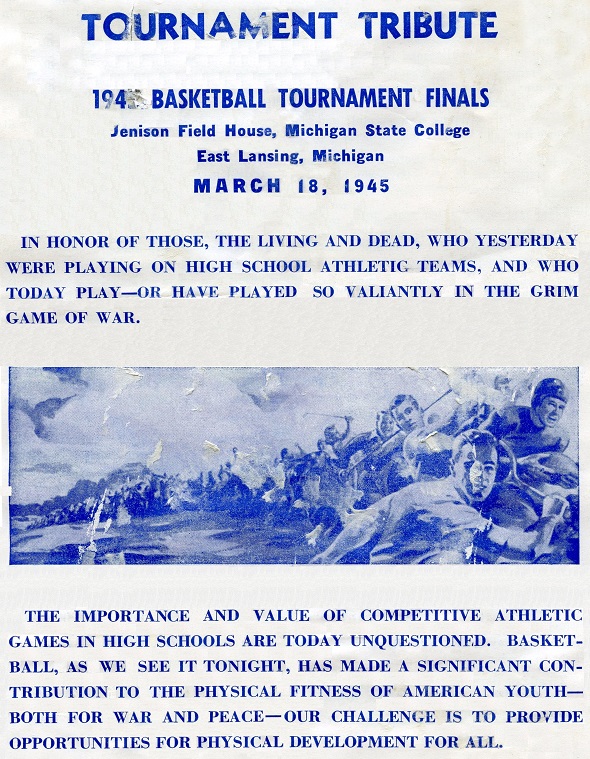
 Ron Pesch has taken an active role in researching the history of MHSAA events since 1985 and began writing for MHSAA Finals programs in 1986, adding additional features and "flashbacks" in 1992. He inherited the title of MHSAA historian from the late Dick Kishpaugh following the 1993-94 school year, and resides in Muskegon. Contact him at [email protected] with ideas for historical articles.
Ron Pesch has taken an active role in researching the history of MHSAA events since 1985 and began writing for MHSAA Finals programs in 1986, adding additional features and "flashbacks" in 1992. He inherited the title of MHSAA historian from the late Dick Kishpaugh following the 1993-94 school year, and resides in Muskegon. Contact him at [email protected] with ideas for historical articles.
PHOTOS: (Top) Grand Rapids Union was among "Area" boys basketball champions in 1943. (2) Lewis Forsythe, left, and Charles Forsythe were among leaders during the MHSAA's first decades (3) The Saginaw Arthur Hill yearbook for 1944 tells of fitness training undertaken by students. (4) Julian W. Smith served as interim MHSAA executive director while Charles Forsythe was serving in the military. (5) Flint Northern's Bill Hamilton earned all-state honors in 1942. (6) Western Michigan College was among hosts of 1943 Area tournaments. (7) Arthur Hill's yearbook celebrates the 1943-44 boys basketball championship. (8) Basketball Finals returned to Jenison Field House in 1945. (9) The MHSAA paid tribute to World War II veterans in its 1945 Basketball Finals program.
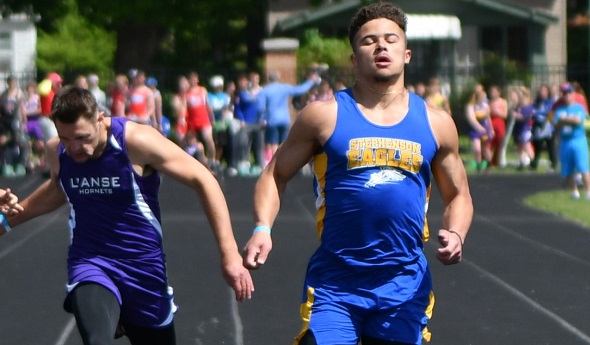
Preview: Don't Miss This Grand Finale
May 31, 2019
By Geoff Kimmerly
Second Half editor
Pick a division – any of seven Saturday – and you’re bound to find a senior standout finishing his career at the MHSAA Boys Track & Field Finals.
Michigan high schools regularly graduate star-loaded classes in this sport – but with reigning champions headlining lineups all over the Lower and Upper Peninsula this weekend, this grand finale guarantees to be memorable.
Below is a look at some of the teams and individuals to watch at Saturday’s boys meets. All events begin at 9 a.m. local time on both peninsulas.
Click for meet information including all qualifiers. Check out MHSAA.tv for live streaming of running events from both peninsulas, available with subscription and beginning at 10 a.m., and come back Saturday night for results as they come in and coverage of all seven meets on Second Half.
LP Division 1 at East Kentwood
Top Regional team scores: 1. Grosse Pointe South 142, 2. East Kentwood 139.5, 3. Alpena 130, 4. Plymouth 125, 5. Macomb Dakota 114.
Team forecast: East Kentwood has won the last two LPD1 championships and seven of the last 10. The Falcons look like significant favorites again with the fastest Regional times in the 400, 800 and 1,600 relays, top-five times in five individual races and contenders in at least three field events.
Detroit Renaissance’s Dylan Brown: The junior sprinter ran the top Regional time in the 200 (21.69) and second-fastest in the 100 (10.75) and also runs on two contending relays. He was part of the winning 800 relay and finished fifth in the 200 last season for Detroit Martin Luther King.
Ann Arbor Pioneer’s Nick Foster: The senior distance standout is looking to add to last season’s championships in the 3,200 and as part of the 3,200 relay. His 9:16.60 in the 3,200 was the third fastest in LPD1 Regionals this spring, and he ran the fastest 1,600 (4:12.87).
Lansing Waverly’s Keshaun Harris: The reigning 300 hurdles champion is seeking to sweep those races after finishing a close second as well in the 110 race last spring. He had the fastest LPD1 Regional time in the 110 (14.23) and sixth-fastest in the 300 (38.71).
Rockford’s Noah Stallworth: After coming in fifth in the 100 and eighth in the 200 as a junior, Stallworth had the fastest 100 (10.54) and second-fastest 200 (21.79) at LPD1 Regionals and runs on 400 and 1,600 relays that both were the third fastest in qualifying. He was part of the 400 relay champion in 2017.
LP Division 2 at Zeeland
Top Regional team scores: 1. Dearborn Divine Child 193, 2. Zeeland West 157, 3. Corunna 139.67, 4. Parma Western 130, 5. Yale 118.
Team forecast: The LPD2 Finals have seen 15 schools win the championship at least once over the last 16 seasons. Zeeland West might the favorite this time, after also winning in 2014, with big scoring possible in the hurdles, middle and distance races, long jump and at least three relays.
Otsego’s Alex Comerford: Last season’s 3,200 champ will look to finish his high school career with a pair of titles after running the second-fastest LPD2 Regional time in that race (9:25.94) and fastest in the 1,600 (4:18.41) – although he faces strong competition in Corunna senior Ben Jacobs and East Grand Rapids junior Evan Bishop.
Tecumseh’s Jacob Denison: The 400 winner last season as a junior had the sixth-fastest LPD2 Regional time in that race (50.25) but the second-fastest in the 200 (22.29) and also runs on an 800 relay that should contend.
Saginaw’s Tony Martin: The reigning long jump champion went over 26 feet during a regular-season meet, which would break the all-Finals record by two feet. He won his Regional at 21-10.25, the second-best jump in LPD2 Regional competition behind the 22-3.5 of Hudsonville Unity Christian junior Isaac TeSlaa.
Coldwater’s Dylan Targgart: Coming off a sweep of the throws last season as a sophomore, Targgart had the best tosses in both the shot put (61 feet) and discus (166-8) at LPD2 Regionals. He should make a run at the LPD2 Finals shot put record of 61-8 set by Ogemaw Heights’ Anthony Zettel in 2011.
LP Division 3 at Jenison
Top Regional team scores: 1. Berrien Springs 174.5, 2. Warren Michigan Collegiate 161, 3. Caro 148, 4. Adrian Madison 139.5, 5. Madison Heights Bishop Foley 134.
Team forecast: Similar to LPD2, this division has seen nine schools take turns winning the last nine championships (although three schools have come in second at least twice during that time). Berrien Springs was the runner-up a year ago and should put up some points – but keep an eye out for Pewamo-Westphalia and Saugatuck. P-W should contend in the throws, sprints, middle distance and at least two relays, while Saugatuck – the Division 4 champion or co-champion three of the last six seasons – has the favorites in both distance and hurdles races.
Saugatuck’s Brad Dunn: After taking third in the 110 and fifth in the 300 hurdles last season, Dunn had the top LPD3 Regional times in both this spring as a senior at 14.66 and 40.18 seconds, respectively.
Saugatuck’s Corey Gorgas: After sweeping the 1,600 and 3,200 last season as a junior, Gorgas is favored to do so with the top LPD3 Regional times of 4:19.24 and 9:43.98, respectively – although 800 favorite Jeremey Kloss from Harbor Springs should be right there with him in the 1,600, as should Caro star Yami Albrecht.
Grandville Calvin Christian’s Caleb Schutte: The senior sprinter won the 100 last year and was on the winning 400 relay as a sophomore. He enters this weekend with the second-fastest LPD3 Regional time in the 100 at 11.01 and the fastest in the 200 at 22.24.
Berrien Springs’ Sam Spaulding: The reigning high jump champ won his Regional at 6-2, which ties him for fifth among all LPD3 Regional performances. He’s gone 6-5 this senior season, which would put him one inch shy of the best qualifying mark.
Kent City’s Giovanni Weeks: Another reigning champion looking to go out on top is Weeks, who won the 200 last season and finished just behind Schutte in that race (22.34) and also in the 100 (11.08) at the Regional. His winning Regional long jump of 21-3.5 was fourth in the division for all Regionals.
LP Division 4 at Hudsonville Baldwin Middle School
Top Regional team scores: 1. Lutheran Westland 172, 2. Southfield Christian 158, 3. Addison 155.25, 4. Maple City Glen Lake 138, 5. Kalamazoo Hackett 135.
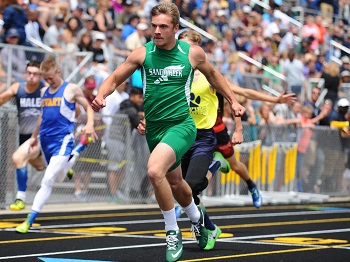 Team forecast: Hackett won its first MHSAA Finals championship in this sport last season, and Addison could become a first-time champ with at least one competitor in all but one race and three of five field events. Hillsdale Academy could be that team this weekend too with favorites in at least three events and a solid contender in a fourth. Breckenridge is another possible first-time champion with the possibility of earning big points in the throws, distance races and sprint relays.
Team forecast: Hackett won its first MHSAA Finals championship in this sport last season, and Addison could become a first-time champ with at least one competitor in all but one race and three of five field events. Hillsdale Academy could be that team this weekend too with favorites in at least three events and a solid contender in a fourth. Breckenridge is another possible first-time champion with the possibility of earning big points in the throws, distance races and sprint relays.
Kalamazoo Hackett’s Heath Baldwin: After winning the 110 hurdles and long jump last year, Baldwin will make a run at four championships in his last high school meet. He had the second-fastest LPD4 Regional times in the 110 (15.06) and 300 hurdles (40.63), tied for the fourth-highest high jump (6-3) and also won his long jump at 20-0.5.
Hale’s Patrick Harris: The champion in the 400 the last two years just missed qualifying in that race but will cap his high school career running the 200 and on a relay.
Sand Creek’s Alec Muck: The senior sprinter is one of the biggest stars competing, regardless of division, as he looks to add to his five championships including with a fourth straight in the 200. His 200 Regional time (22.85) came in fourth overall for LPD4 and his 100 time of 11.04 ranks second as he looks to win that title for the third straight season. He’s also part of the fastest 400 relay (44.44) coming off LPD4 Regional competition.
Carson City-Crystal’s Daniel Smith: The reigning shot put champ had the second-longest toss during LPD4 Regionals at 51-11.25, but again must contend with another senior, Breckenridge’s Brennan Waslusky (54-9.5) after finishing second to him at that meet two weeks ago.
UP Division 1 at Kingsford
Top Regional team scores: 1. Gladstone 79.5, 2. Ishpeming Westwood 56, 3. Marquette 55.5.
Team forecast: Gladstone will attempt to break Marquette’s four-year hold on Upper Peninsula Division 1 after coming in third a year ago. The Braves had 10 event champions at their Regional to Marquette’s four in the same meet.
Gladstone’s Adam Bruce: The 3,200 champion in 2017 as a sophomore, Bruce will try to finish his senior season with a distance sweep after posting the fastest 1,600 (4:40.73) and second-fastest 3,200 (10:29.38) at UPD1 Regionals.
Marquette’s Raphael Millado: The senior standout won both the long and high jumps last season and enters with the best UPD1 Regional showings in both at 19-11 and 6-2, respectively. He also had the fourth-fastest 200 qualifying time (24.12).
Escanaba’s Dayton Miron: The reigning pole vault champion enters this weekend’s meet tied with the second-highest vault at a UPD1 Regional (11-0), and he’ll also cap his junior season running on three relays.
Gladstone’s Calvin Thibault: The sophomore sprinter/hurdler could end up the star of this meet. He won the 110 and 300 hurdles last season and had the fastest UPD1 Regional times in those races two weeks ago at 15.40 and 41.25, respectively. He also paced the UPD1 qualifiers in the 100 (11.49) and 200 (23.64).
UP Division 2 at Kingsford
Top Regional team scores: 1. Newberry 74, 2. Ishpeming 65, 3. Norway 52.5.
Team forecast: Ishpeming is the reigning champion and has won four of the last five UPD2 titles, with Newberry defeating the runner-up Hematites to claim the championship in 2017. They competed in and won separate Regionals two weeks ago, but on paper Newberry appears to have the upper hand.
Manistique’s Schyler Andersen: The junior standout will make a run at four individual titles with the fastest UPD2 Regional time in the 400 (52.61), top discus throw (140-10), second-best shot put (43-0) and second-fastest 200 (23.70). His best at the 2018 Finals was a fourth place in shot put.
Gwinn’s David Duvall: After taking eighth in the 110 hurdles a year ago as a freshman, Duvall could make a big jump entering this weekend with the top UPD2 Regional times in the 100 (17.72) and 300 (45.35) and the second-best long jump (17-7.5).
Newberry’s Jaylen James: He’s ready to lead Newberry’s team title hunt after helping two relay champs a year ago. He enters with the best UPD2 Regional long jump (18-10), 100 (tie – 11.49), 200 (23.15) and running on the favored 800 relay (1:38.53).
Manistique’s Alex Misniakiewicz: The junior got close last season with two second places and a third in individual events. He enters this weekend as the top qualifier in the 800 (2:10.51), 1,600 (4:44.94) and second-best in the 3,200 (10:49.24).
UP Division 3 at Kingsford
Top Regional team scores: 1. Rapid River 105, 2. Bessemer 86, 3. Brimley 72.5.
Team forecast: Bessemer last season won its first championship in this sport since 1951 and should be in the mix again with the top performers from all UPD3 Regionals combined in nine events. Rapid River was the runner-up in 2018 after two straight titles in 2016 and 2017.
Bessemer’s Uriah Aili: The reigning champion in the 3,200 will make a run at winning at least three races as a senior with the top UPD3 Regional times in the 800 (2:02.41) and 3,200 (10:09.5) and second-fastest in the 1,600 (4:44.49). He also qualified in discus (103-3).
Cedarville’s Thomas Bohn: His 4:33.24 a year ago is the meet record, and he’s ahead of Aili in that race coming into this weekend at 4:43.81. Bohn, a junior, also will run the 3,200 (11:01.82) and 800 (2:07.84).
Bessemer’s Tyler Busch: The reigning shot put champion will look to repeat as a senior, entering with the best toss from UPD3 Regionals at 46-6.
Stephenson’s Montel Glover: The top UPD3 Regional performer in the 100 (11.30), 200 (23.85) and 400 (51.39) won all three of those races in UPD2 the last two seasons, and he’ll also run on a 1,600 relay with a chance at a title.
Bessemer’s Jamie Jett: He’ll look to add to his 2018 110 hurdles and 800 relay championships as a junior, entering this weekend with the top UPD3 Regional times in the 110 (16.76) and 300 (44.11). He’s also running the 200 (24.60) and competing in long jump (18-1.5).
PHOTOS: (Top) Stephenson’s Montel Glover, right, finishes just ahead of L’Anse’s Foster Miller in the 200 at last season’s UP Division 2 Finals. (Middle) Sand Creek’s Alec Muck powers through for one of his sprint championships in LP Division 4 last spring. (Click to see more from RunMichigan.com.)

